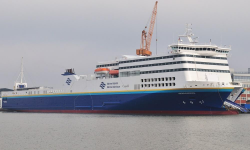Defence in a Competitive Age, elaborated further on the Type 32 frigate stating that it would be designed to protect territorial waters, to provide persistent presence and to support the Royal Navy's new
Littoral Response Groups (LRGs). The document also stated that, along with the Type 31, the frigates would be more flexible than their predecessors, featuring a
modular design, and equipped with advanced sensors and weapons.
[6] According to the document, the ships are likely to be built at Scottish shipyards, like the Type 26 and Type 31.
[6]
During the
DSEI exhibition in September 2021,
Babcock International revealed it was pitching its Arrowhead 140 design, used by the Type 31 frigate, as the base design for the Type 32. The company's Chief Corporate Affairs Officer John Howie stated that the design was well suited to the Royal Navy's requirements for the Type 32, with a flexible mission bay capable of operating subsurface and airborne autonomous systems.
[7]
In November 2021, Royal Navy
First Sea Lord Tony Radakin announced that the ship had entered its concept phase. He added that it was too early to define its characteristics but being a "Type 31 Batch 2" frigate could be an option. Radakin also reiterated the intent of the programme to provide "additional volume" to the fleet and embrace emerging technology.
[8] The revised National Shipbuilding Strategy, released in March 2022, suggested that the Type 32 frigates were likely to be "the first of a new generation of warships with a focus on hosting and operating autonomous onboard systems".
[9] Earlier comments by the UK's Minister for Defense Procurement, Jeremy Quin, also suggested that the new Type 32 frigate will be a platform for autonomous systems, adding to the Royal Navy's capabilities for missions such as anti-submarine warfare and mine countermeasures.
[10]










